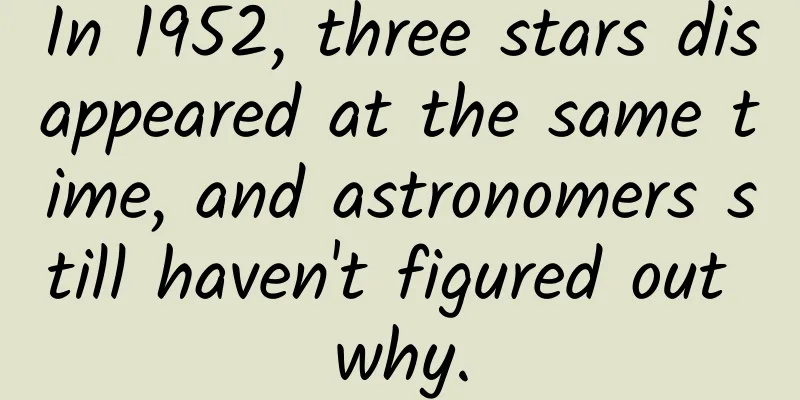In 1952, three stars disappeared at the same time, and astronomers still haven't figured out why.

|
For most people, the starry sky is eternally brilliant and unchanging. But when astronomers looked through historical data, they found that three stars suddenly disappeared together . And to this day, they have not found a reliable explanation. On the evening of July 19, 1952, the Palomar Observatory in California, USA, continued to photograph the sky as usual. At around 8:52 p.m., the telescope captured three stars clustered together, which were unremarkable, although they were quite bright in the image taken by the camera. However, at 9:45 p.m., when the telescope photographed the same area of the sky again, the three stars disappeared. The two observations used different bands and sensors, so the images are slightly different. Image source: Monthly Notices of the Royal Astronomical Society, Volume 527, Issue 3, January 2024, Pages 6312–6320 According to the observation performance of the Palomar Observatory at that time, the brightness of these three stars was reduced to at least one percent of the original. In 2023, astronomers observed this area of the sky with a more advanced telescope and still did not find these three stars. This means that the brightness of the three stars observed by the Palomar Observatory at 8:52 pm on July 19, 1952 was reduced to at least one ten-thousandth of the original brightness. Or, they disappeared completely. Doubts abound Stars can explode, but they usually don’t disappear. For example, a supernova explosion can instantly destroy a star, and its brightness will continue to decay after the explosion, but it is impossible for it to disappear directly within a day. For example, the "Song History·Astronomy Records" once recorded: "In the first year of Zhihe, on May Jichou, it appeared a few inches southeast of Tianguan, and it disappeared slightly after a year." The Tianguan guest star (SN 1054) that exploded in mid-1054 did not weaken in brightness until the end of the year. To this day, we can still see the Crab Nebula created by the Tianguan guest star and the pulsar at its center. These are the remains of supernova explosions, and they can still be observed by us nearly a thousand years later. But in 1952, the three stars disappeared together in less than 50 minutes. This is not right. What's even stranger is that these three stars are very close to each other, less than 10 arc seconds apart. If they are three separate celestial bodies, then the distance between them will not exceed 50 light minutes (the distance that light travels in 50 minutes), which is about 6 times the distance from the Earth to the Sun (6 AU), and is comparable to the average distance between the Sun and Jupiter (5.2 AU). At most 50 light minutes apart, it seems less than 10 arc seconds apart to us. After simple geometric conversion, these three stars are no more than 2 light years away from us - in comparison, the nearest star to the Sun is 4.2 light years away. Astronomically, this distance is incredibly close. The question is so bizarre that we naturally have to consider some unreliable answers. Is it possible that these three bright spots are not stars in the sky, but are caused by factors on the ground - such as radioactive dust produced by nuclear tests . The Palomar Observatory is not far from New Mexico, the United States, where the first atomic bomb was detonated and the subsequent nuclear test site. Bright spots caused by radioactive dust also appeared on photographic films in the 1950s, and the influence of ground factors must be considered. The Palomar Observatory is not far from the US nuclear test site in New Mexico. So astronomers analyzed the outlines of these three stars. Among the three stars, one is slightly farther away from the other two, so their outlines can be compared with those of nearby normal stars. It was found that the outlines of these three stars are almost exactly the same as those of normal stars. If they were bright spots caused by radioactive dust, such a result would not be possible. If it were a fast-moving target such as an airplane or an asteroid, the outline on the film should be a straight line. It can be basically confirmed that these bright spots are produced by normal imaging of the telescope. The white dots are the contour curves of the vanishing stars, and the white lines are the contour curves of the normal stars. It can be seen that the two are basically the same. The upper and lower figures are the contours in the east-west direction and the north-south direction respectively. Image source: Monthly Notices of the Royal Astronomical Society, Volume 527, Issue 3, January 2024, Pages 6312–6320 Really three? Or, they are not three stars at all. Rather, one star suddenly disappears, and it is only because of the influence of gravitational lensing that we see the image of three stars. Gravity can distort light, so it can produce a lens-like effect. For the simplest gravitational lens - consisting of a celestial body - if the gravitational lens happens to be located on the line between the earth and the target celestial body, then the gravitational lens will distort the original image of a star into a ring, also called an Einstein ring; if the gravitational lens is slightly off, then only two images of similar brightness will be formed . There may be another image in the middle of the two images, but it is much weaker. There is a gravitational lens in the middle of the picture (the lens itself is in the middle of the picture, not marked in the picture). When the point light source (cyan circle) behind the gravitational lens passes through the back of the gravitational lens, we can only see the distorted image, which is the white part. Image source: wikipedia If you want to form three images of similar brightness, then the structure of the gravitational lens should be very special, such as multiple black holes, or a mass of uneven dark matter. At the same time, under the influence of this complex gravitational lens, the optical path lengths of the three images cannot differ by more than 50 light minutes, otherwise we will not be able to see the three bright spots disappear at the same time. This conjecture comes from a paper in the Monthly Notices of the Royal Astronomical Society (MNRAS). It is worth noting that the authors of the paper think that this gravitational lens is too complicated and only give rough restrictions. Interested readers can calculate the structure of this gravitational lens by themselves and then publish a paper. Only guesswork Even if such a complex gravitational lens really exists, the most critical question has not been answered - stars only explode, not suddenly disappear, so how did this star disappear within an hour? In fact, if there is only one star that actually disappears, then we can find many similar examples. The VASCO project (Vanishing & Appearing Sources during a Century of Observations) counted how many stars had suddenly disappeared in the past 70 years. In 2019, they published a paper in the Astronomical Journal (AJ), stating that about 100 sources had disappeared without any basis , and there was no reliable explanation at all. Without a reliable explanation, we can only guess. Could it be the optical counterpart of a fast radio burst (FRB) ? A fast radio burst is an astronomical phenomenon in the radio band that can burst out huge amounts of energy in a few milliseconds. The corresponding optical phenomenon of this millisecond-level astronomical phenomenon may indeed last less than an hour. However, due to insufficient relevant data, it is currently difficult for us to verify this conjecture. In May this year, a paper published in Physical Review Letters (PRL) gave a new possibility - these suddenly disappeared stars may have become black holes. The research team studied the binary star system VFTS 243 at the edge of the Milky Way, which consists of a star and a black hole. It is generally believed that the black hole should be produced by a supernova explosion. The impact of the supernova explosion will change the orbit of the binary star and make it elliptical . However, in VFTS 243, the eccentricity of the binary orbit is only 0.017, which is close to a perfect circle, which is inconsistent with the traditional supernova model. After further calculations and simulations, the research team proposed that the black hole in VFTS 243 may be formed by the direct collapse of a massive star. The paper points out that when a star dies, if the core mass is more than 10 times the mass of the sun, it may collapse directly into a black hole. A bright star just disappeared suddenly. VFTS 243 Artistic Imagination. Image credit: ESOL. Calçada CC BY 4.0 There was no supernova explosion, but a sudden and quiet disappearance . This may answer the questions of the VASCO project, and may also be the answer to the three stars that disappeared in 1952. So, how did these three stars disappear in 1952? At present, the more likely explanation is that these three stars are actually just one star, and the three stars observed from Earth are actually images produced by a complex gravitational lens. As for why that star suddenly disappeared? It could be the optical counterpart of FRB, or it could be the silent birth of a black hole. But this is still just speculation and has not been verified by any paper. References [1]Beatriz Villarroel et al 2020 AJ 159 8 https://iopscience.iop.org/article/10.3847/1538-3881/ab570f [2]Monthly Notices of the Royal Astronomical Society, Volume 527, Issue 3, January 2024, Pages 6312–6320, https://academic.oup.com/mnras/article/527/3/6312/7457759 [3]Phys. Rev. Lett. 132, 191403 https://doi.org/10.1103/PhysRevLett.132.191403 [4]https://www.universetoday.com/163820/in-1952-a-group-of-three-stars-vanished-astronomomers-still-cant-find-them/ [5]https://www.iflscience.com/hundreds-of-stars-have-vanished-without-a-trace-a-new-study-could-explain-why-74343 [6]https://zh.wikipedia.org/wiki/SN_1054 [7]http://www.nao.cas.cn/twsdjz/sdjzndhx/sdjzjcl/202103/P020210325380297688434.pdf [7] https://vascoproject.org [8]https://science.ku.dk/english/press/news/2024/complete-stellar-collapse-unusual-star-system-proves-that-stars-can-die-quietly/ [9]https://www.iflscience.com/hundreds-of-stars-have-vanished-without-a-trace-where-did-they-go-71397 Planning and production Source: Global Science (id: huanqiukexue) Editor: Yang Yaping Proofread by Xu Lai and Lin Lin |
<<: What is the "piping" phenomenon of Dongting Lake's dam bursting? How to rescue it?
>>: Suddenly I felt my heart skip a beat. Is it serious?
Recommend
PPT comes true, Tesla shows 4680 battery production line, mileage increased by 16%
Recently, Tesla officially released a video showi...
What are the promotion channels of Xiaohongshu? How to promote?
Internet business is all about traffic. The essen...
What pitfalls will you encounter when you go from a novice to an expert in operations? How to avoid it?
It is not an exaggeration to say that good operat...
Operation and Promotion | Teach you step by step how to capture fans with an event!
How to attract fans to a public account by planni...
@Everyone! Tips for "emergency handling" during May Day travel are waiting for you to check
The May Day holiday is coming, and many people mu...
Have you ever taken one of these high-tech buses?
The environment in big cities is getting worse an...
Online education customer acquisition methods and conversion strategies!
Out of curiosity about the online education indus...
Mainstream App promotion and customer acquisition channels and methods!
With the development of App development technolog...
Even if you have disabled or uninstalled the app, it will still automatically renew! Expert advice: You can turn off the automatic renewal of Alipay and WeChat
Nowadays, copyright awareness in the domestic mar...
How to bring about conversions by building an operation system and channel diversion?
1. What is operation in your mind? The operation ...
Celebrate Chinese New Year with a scientific flavor | There is a "dragon" in these flowers!
|||| Written by reporter Ji Jingjing Edited by Ch...
Will Apple open up its iOS operating system? It missed the opportunity 30 years ago
US financial website Marketwatch wrote on Thursda...
Advertising creative production methodology
I believe that many of my friends have also seen ...
Implementing system sound recording in Android-RK3399 development board source code modification
Preface I have been recording system sound these ...
Meizu Flyme Developer Salon opens in Beijing to create and grow together
[[139121]] On July 8, 2015, Meizu's "Sta...




![[Infographic] WeChat Enterprise Account](/upload/images/67ebf29462068.webp)




